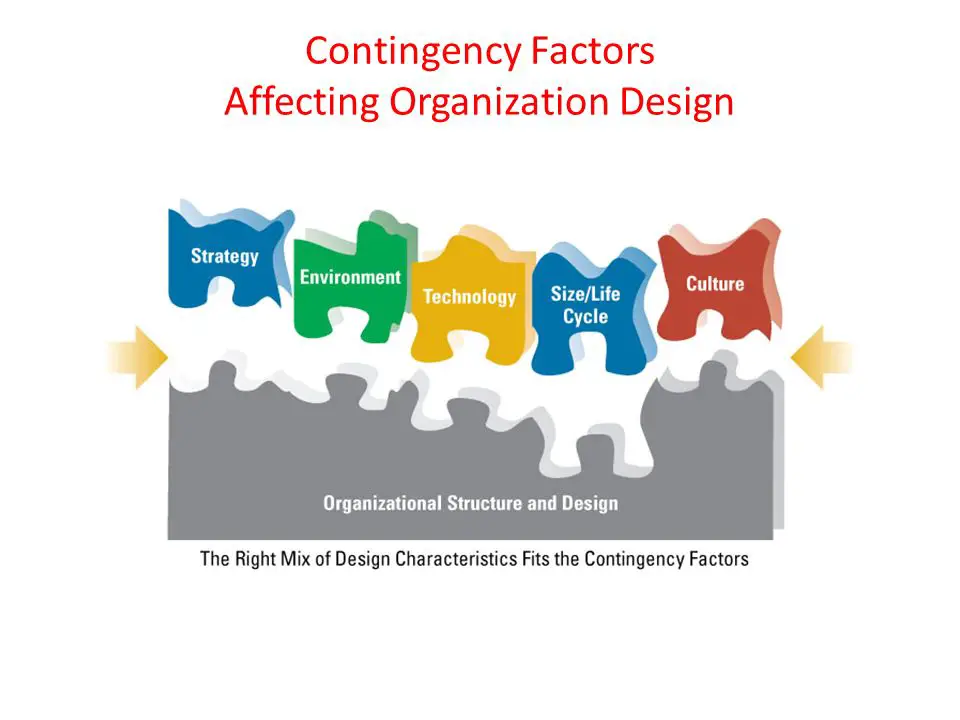Contingency
Key Contingencies Affecting Organization Design
Contingency means that one thing depends on other things, and for organizations to be effective there must be a “goodness of fit” between their design and various contingency factors.
What works in one setting may not work in another setting. There is no “one best way.” Contingency theory means it depends.
For example, a government agency may experience a certain environment, use a routine technology, and desire efficiency. In this situation, a management approach that uses bureaucratic control procedures, a hierarchical structure, and formalized communications would be appropriate.
Likewise, free-flowing design and management processes work best in a high-tech company that faces an uncertain environment with a non-routine technology. The correct approach is contingent on the organization’s situation.
Many problems occur when all organizations are treated as similar, which was the case with scientific management and administrative principlesOpens in new window that attempted to design all organizations alike.
The structures and systems that work in the retail division of a conglomerate will not be appropriate for the manufacturing division. The organization charts and financial procedures that are best for an entrepreneurial Internet firm like Instagram will not work for a large food processing plant at Oscar MayerOpens in new window or a large nonprofit organization such as United WayOpens in new window.
| Briefcase |
|---|
| As an organization manager, keep these guidelines in mind: Be cautious when applying something that works in one situation to another situation. All organizational systems are not the same. Use organization design concepts to identify the correct structure and management systems for each organization. |
A basic premise of the above text is that effective organization design means understanding various contingencies and how organizations can be designed to fit contingency factors.
Contingency factors include organizations size, technology, environmentOpens in new window, goals and strategyOpens in new window, and organizational cultureOpens in new window. The organization is designed to “fit” the contingency factors, as illustrated in Figure X-1.
 Figure X-1 Contingency Factors Affecting Organization Design | Credit — SlidePlayer Opens in new window
Figure X-1 Contingency Factors Affecting Organization Design | Credit — SlidePlayer Opens in new window
In a stable environment, for example, the organization can have a traditional mechanistic structure that emphasizes vertical control, efficiency, specialization, standard procedures, and centralized decision making.
However, a rapidly changing environment may call for a more flexible, organic structure, with strong horizontal coordination and collaboration through teams or other mechanisms. Environment is discussed in a designated volumeOpens in new window.
In terms of size and life cycle, young, small organizations are generally informal and have little division of labor, few rules and regulations, and ad hoc budgeting and performance systems. Large organizations such as Coca-ColaOpens in new window, SamsungOpens in new window, or General ElectricOpens in new window, on the other hand, have an extensive division of labor, numerous rules and regulations, and standard procedures and systems for budgeting, control, rewards, and innovation.
Design must also fit the workflow technology of the organization. For example, with mass production technology, such as a traditional automobile assembly line, the organization functions best by emphasizing efficiency, formalization, specialization, centralized decision making, and tight control.
An e-businessOpens in new window, on the other hand, would need to be more informal and flexible. Technology’s impact on design is also a contingent factor. A final contingency that affects organization design is corporate culture. An organizational cultureOpens in new window that values teamwork, collaboration, creativity, and open communication, for example, would not function well with a tight, vertical structure and strict rules and regulations. The role of culture is also a factor.
One responsibility of managers is to design organizations that fit the contingency factors of strategy, environment, size and life cycle, technology, and culture. Finding the right fit leads to organizational effectivenessOpens in new window, whereas a poor fit can lead to decline or even the demise of the organization.
| Remember This |
|---|
|
The series:
- Research data for this work have been adapted from the manual:
- Managerial Accounting: Tools for Business Decision Making By Jerry J. Weygandt, Paul D. Kimmel, Donald E. Kieso

